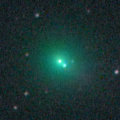
|
Brightened rapidly, and it reached to 5 mag in early June (June 5, Yoshimi Nagai). It will approach to the sun down to 0.4 A.U. in July, and it was expected to reach up to 2-3 mag. However, its brightening has stopped after that. Now it is 5.5 mag (June 18, Juan Jose Gonzalez). In the Northern Hemisphere, it is observable only until late June.
Date(TT) R.A. (2000) Decl. Delta r Elong. m1 Best Time(A, h)
June 19 4 40.59 48 14.3 1.143 0.542 28 5.0 5:36 (224,-19)
June 26 6 14.53 44 16.4 1.204 0.443 20 5.0 5:37 (233,-27)
|
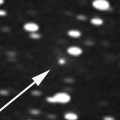
|
Brightened rapidly. Now it is so bright as 9.1 mag (June 18, Juan Jose Gonzalez). It keeps observable bright as 9-10 mag for a long time until autumn.
Date(TT) R.A. (2000) Decl. Delta r Elong. m1 Best Time(A, h)
June 19 23 11.00 -6 55.3 0.828 1.433 101 9.7 5:23 (180, 62)
June 26 23 31.80 -6 48.4 0.793 1.426 103 9.5 5:16 (180, 62)
|
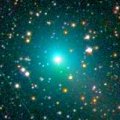
|
It brightened up to 7.9 mag in April and May (May 5, Juan Jose Gonzalez). Now it is fading. But it is still bright as 8.5 mag (June 18, Juan Jose Gonzalez). It keeps observable for a long time until when it fades out in the Northern Hemisphere. It will be visible visually until autumn, although it will be low in July.
Date(TT) R.A. (2000) Decl. Delta r Elong. m1 Best Time(A, h)
June 19 7 8.94 67 58.6 2.115 1.591 46 9.7 18:26 (156,-27)
June 26 7 22.16 65 13.1 2.225 1.638 43 9.9 18:27 (152,-28)
|

|
It passes the perihelion in August. But the condition of this apparition is bad. It is not observable in the Northern Hemisphere. In the Southern Hemisphere, it appears in the evening sky at 9 mag in late August, then it will keep observable while fading rapidly.
Date(TT) R.A. (2000) Decl. Delta r Elong. m1 Best Time(A, h)
June 19 3 57.66 26 41.3 1.930 1.101 25 12.3 5:36 (236, 1)
June 26 4 29.89 27 54.8 1.814 0.988 24 11.6 5:37 (236, -1)
|
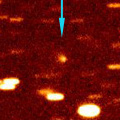
|
It brightened up to 15.5 mag in January (Jan. 31, C. Rinner, F. Kugel). It is not observable now. The condition of this apparition is bad. It will reach up to 11-12 mag from spring to autumn, but it is not observable.
Date(TT) R.A. (2000) Decl. Delta r Elong. m1 Best Time(A, h)
June 19 5 8.80 22 40.9 2.358 1.365 9 11.7 5:36 (249,-10)
June 26 5 34.47 22 12.3 2.348 1.359 10 11.6 5:37 (249, -9)
|
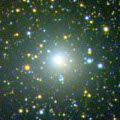
|
It reached up to 7.7 mag in last summer (Aug. 13, Chris Wyatt). It is fading now. It has already faded down to 11.5 mag (June 19, Marco Goiato). In the Southern Hemisphere, it keeps observable for a long time after this. In the Northern Hemisphere, it is only observable in the low sky. It will be getting lower gradually, then it will never be observable again.
Date(TT) R.A. (2000) Decl. Delta r Elong. m1 Best Time(A, h)
June 19 19 15.75 -43 25.9 3.582 4.512 153 11.7 1:29 ( 0, 82)
June 26 19 2.43 -44 40.2 3.605 4.557 156 11.8 0:49 ( 0, 80)
|
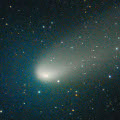
|
It reached up to 9.2 mag in March (Mar. 20, Marco Goiato). Now it is fading, but still bright as 11.4 mag (June 16, Marco Goiato). It keeps observable in a good condition for a long time. It keeps observable until autumn when it fades down to 16 mag.
Date(TT) R.A. (2000) Decl. Delta r Elong. m1 Best Time(A, h)
June 19 14 15.73 -8 0.2 1.165 1.951 126 12.2 20:26 (180, 63)
June 26 14 21.62 -8 52.6 1.254 1.987 121 12.4 20:04 (180, 64)
|

|
Chris Wyatt reported it was visible visually at 11.3 mag on Apr. 25. But no other observations have been reported. The condition of this apparition is very bad. It will never be observable after this.
Date(TT) R.A. (2000) Decl. Delta r Elong. m1 Best Time(A, h)
June 19 5 20.61 22 25.9 1.833 0.832 6 12.3 5:36 (251,-12)
June 26 5 56.42 21 37.5 1.892 0.885 5 12.8 5:37 (252,-13)
|

|
Now it is 12.6 mag (June 12, Marco Goiato). It will keep 12-13 mag until autumn. But it locates somewhat low in the Northern Hemisphere.
Date(TT) R.A. (2000) Decl. Delta r Elong. m1 Best Time(A, h)
June 19 21 15.57 -27 51.8 1.721 2.531 133 12.8 3:28 (180, 83)
June 26 21 15.21 -28 37.7 1.678 2.542 140 12.8 3:00 (180, 84)
|
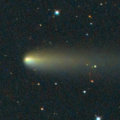
|
It brightened up to 9.5 mag in January (Jan. 13, Juan Jose Gonzalez). Now it is fading rapidly. But it is still bright as 12.3 mag (June 4, Juan Jose Gonzalez). It will be observable in good condition for a long time after this in the Northern Hemisphere. It keeps visible visually until summer. In mid March, the nuclear fragmentation was observed.
Date(TT) R.A. (2000) Decl. Delta r Elong. m1 Best Time(A, h)
June 19 14 33.72 59 32.0 3.465 3.576 87 13.8 20:43 (180, -4)
June 26 14 34.61 58 15.9 3.554 3.631 86 14.0 20:17 (180, -3)
|

|
Great outburst up to 11 mag occured on Feb. 2. Another new minor outburst occured on Apr. 16 (Albert Sanchez Caso). It is bright as 11.8 mag still now (June 3, Juan Jose Gonzalez).
Date(TT) R.A. (2000) Decl. Delta r Elong. m1 Best Time(A, h)
June 19 9 34.98 11 38.5 6.746 6.216 54 14.1 18:26 (133, 30)
June 26 9 38.83 11 17.4 6.835 6.217 49 14.1 18:27 (128, 26)
|
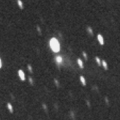
|
Now it is 15.6 mag (June 7, Toni Scarmato). It is also visible visually at 14.5 mag (Apr. 10, Juan Jose Gonzalez). It keeps observable at 15 mag for a long time in 2010.
Date(TT) R.A. (2000) Decl. Delta r Elong. m1 Best Time(A, h)
June 19 17 45.78 41 8.3 4.057 4.586 115 15.2 23:54 (180, 14)
June 26 17 41.76 41 42.0 4.062 4.577 114 15.1 23:23 (180, 13)
|
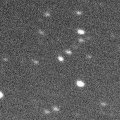
|
Now it is 15.5 mag (May 14, Richard Brown). It keeps bright as 14-15 mag for a long time after this until 2013. It is observable in good condition in the Southern Hemisphere. However, it is not observable in the Northern Hemisphere.
Date(TT) R.A. (2000) Decl. Delta r Elong. m1 Best Time(A, h)
June 19 14 41.24 -48 20.1 6.032 6.795 135 15.2 20:51 ( 0, 77)
June 26 14 36.14 -48 14.3 6.068 6.766 129 15.2 20:18 ( 0, 77)
|

|
Now it is 15.6 mag (June 8, Robert McNaught). It is expected to keep so bright as 6-8 mag for a long time from 2011 to 2012, and to be observable in good condition in the Northern Hemisphere. In 2010, it is observable in good condition in the Southern Hemisphere while brightening slowly. It locates low in the Northern Hemisphere, but it keeps observable until the end of 2010.
Date(TT) R.A. (2000) Decl. Delta r Elong. m1 Best Time(A, h)
June 19 23 58.17 -32 37.1 5.963 6.230 100 15.3 5:36 (253, 82)
June 26 23 57.26 -33 0.3 5.803 6.171 106 15.2 5:37 (204, 88)
|
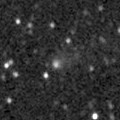
|
Now it is visible visually at 14.3 mag (May 21, Alan Hale). It keeps observable for a long time until September when it becomes fainter than 18 mag.
Date(TT) R.A. (2000) Decl. Delta r Elong. m1 Best Time(A, h)
June 19 16 12.44 -25 33.2 0.847 1.829 157 15.3 22:22 (180, 81)
June 26 16 14.69 -24 46.3 0.896 1.856 151 15.4 21:57 (180, 80)
|
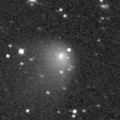
|
Bright new comet discovered as a bright stellar object of 12.5 mag on Apr. 16. It was not detected, fainter than 20 mag, on the previous day (Apr. 15, Catalina Sky Survey). It was discovered just after the sudden outburst. It is bright as 12.0 mag still now (June 6, Jose Guilherme S. Aguiar), but it looks diffuse. It has faded down to 14.3 mag by CCD observations (June 3, Ken-ichi Kadota).
Date(TT) R.A. (2000) Decl. Delta r Elong. m1 Best Time(A, h)
June 19 13 16.03 1 1.5 2.652 3.140 109 15.3 19:26 (180, 54)
June 26 13 17.93 0 10.2 2.745 3.144 103 15.7 19:00 (180, 55)
|

|
Brightening rapidly. Now it is 16.6 mag (June 14, C. Rinner, F. Kugel). This apparition is best condition. It will approach to the earth down to 0.12 A.U. in October, and brighten up to 5 mag. It will be visible with naked eyes. In the Northern Hemisphere, it keeps observable all through this apparition until 2011 June when it fades down to 17 mag.
Date(TT) R.A. (2000) Decl. Delta r Elong. m1 Best Time(A, h)
June 19 21 52.71 8 40.7 1.322 1.950 112 15.9 4:05 (180, 46)
June 26 21 59.50 10 47.6 1.207 1.888 116 15.4 3:44 (180, 44)
|
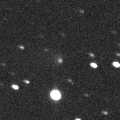
|
Now it is 15.7 mag (June 14, Catalina Sky Survey). It will be observable at 13-14 mag for a long time from 2011 to 2012. In 2010, it is observable at 15-16 mag in good condition from spring to autumn.
Date(TT) R.A. (2000) Decl. Delta r Elong. m1 Best Time(A, h)
June 19 21 46.65 2 10.4 6.587 7.104 116 15.5 3:59 (180, 53)
June 26 21 42.58 2 5.7 6.450 7.070 124 15.4 3:28 (180, 53)
|
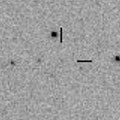
|
It had been unobservable for a while, but it is getting observable in the morning sky now. Now it is 16.1 mag (June 3, Francois Kugel). It keeps observable after this while fading gradually.
Date(TT) R.A. (2000) Decl. Delta r Elong. m1 Best Time(A, h)
June 19 3 13.45 44 51.5 2.819 2.115 38 15.6 5:36 (217, -5)
June 26 3 31.36 47 15.9 2.821 2.157 40 15.8 5:37 (214, -6)
|

|
Now it is 16.0 mag (June 12, Toshiyuki Takahashi). It was observed as 15-16 mag in early 2009. In 2010, it was also observed at 16 mag in good condition from winter to spring. But it will be getting lower in the evening sky after this. It will be too low to observe in August.
Date(TT) R.A. (2000) Decl. Delta r Elong. m1 Best Time(A, h)
June 19 13 18.66 -2 37.3 3.229 3.725 111 16.0 19:29 (180, 58)
June 26 13 20.01 -3 1.5 3.331 3.731 105 16.0 19:02 (180, 58)
|

|
It brightened up to 11 mag in spring and summer in 2009. Appearing in the morninig sky again. Now it is 16.4 mag (May 1, Ken-ichi Kadota). It keeps observable after this until autumn when it becomes fainter than 18 mag while fading gradually. But it locates somewhat low in the Northern Hemisphere.
Date(TT) R.A. (2000) Decl. Delta r Elong. m1 Best Time(A, h)
June 19 20 3.77 -25 40.2 2.140 3.059 149 16.6 2:17 (180, 81)
June 26 19 58.86 -25 59.4 2.123 3.085 157 16.7 1:44 (180, 81)
|

|
Now it is 16.7 mag (June 13, Hidetaka Sato). It will be observable at 17 mag in good condition in summer.
Date(TT) R.A. (2000) Decl. Delta r Elong. m1 Best Time(A, h)
June 19 21 23.69 -6 42.3 2.693 3.390 125 17.0 3:37 (180, 62)
June 26 21 10.55 -5 41.5 2.598 3.393 134 16.9 2:56 (180, 61)
|

|
It brightened up to 13 mag and observed visually from 2007 to 2009. Due to the far distance, it is bright as 15.8 mag still now (June 12, Ken-ichi Kadota). It will be getting lower in the evening sky after this, and it will be too low to observe in August. However, it will be observable in good condition again at 17.5 mag in autumn.
Date(TT) R.A. (2000) Decl. Delta r Elong. m1 Best Time(A, h)
June 19 11 37.33 40 14.1 8.569 8.329 72 16.9 18:26 (172, 14)
June 26 11 36.25 39 44.3 8.698 8.362 67 17.0 18:27 (167, 14)
|

|
Now it is 16.7 mag (June 20, F. Garcia). It keeps 17 mag for a while after this.
Date(TT) R.A. (2000) Decl. Delta r Elong. m1 Best Time(A, h)
June 19 15 18.45 -3 47.4 1.676 2.530 138 17.0 21:28 (180, 59)
June 26 15 17.75 -4 43.3 1.712 2.515 132 17.0 21:00 (180, 60)
|
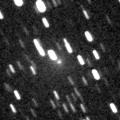
|
It had been observed bright as 13-14 mag from January to May. But it is fading rapidly now. It was still bright as 15.6 mag on June 3 (Hidetaka Sato). But it will be fainter than 18 mag soon.
Date(TT) R.A. (2000) Decl. Delta r Elong. m1 Best Time(A, h)
June 19 11 56.88 36 1.9 1.831 1.900 77 17.1 18:26 (176, 19)
June 26 12 8.85 31 17.3 1.939 1.963 76 17.4 18:27 (172, 24)
|
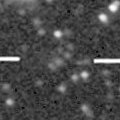
|
Now it is 17.2 mag (June 2, Ken-ichi Kadota). It keeps observable at 17.5 mag in good condition for a long time in 2010.
Date(TT) R.A. (2000) Decl. Delta r Elong. m1 Best Time(A, h)
June 19 19 47.74 85 52.0 5.110 4.861 70 17.4 2:02 (180,-31)
June 26 18 5.56 85 33.3 5.100 4.866 71 17.4 23:36 (180,-30)
|

|
Now it is 17.0 mag (June 9, Yasukazu Ikari). It keeps observable at 17-18 mag for a long time until 2011 summer.
Date(TT) R.A. (2000) Decl. Delta r Elong. m1 Best Time(A, h)
June 19 20 24.45 8 58.1 3.503 4.230 130 17.6 2:37 (180, 46)
June 26 20 13.64 9 56.9 3.414 4.208 136 17.5 1:59 (180, 45)
|
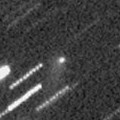
|
It was bright as 15 mag in early May at the discovery. But it is fading rapidly. It has already faded down to 17.2 mag (June 7, P. C. Sherrod). It will be fainter than 18 mag soon.
Date(TT) R.A. (2000) Decl. Delta r Elong. m1 Best Time(A, h)
June 19 14 5.52 24 40.2 1.867 2.380 107 17.6 20:14 (180, 30)
June 26 13 53.66 24 52.4 2.049 2.438 99 17.9 19:35 (180, 30)
|
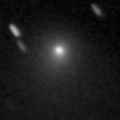
|
Now it is 17.7 mag (June 4, P. Bacci). It will be fainter than 18 mag in July.
Date(TT) R.A. (2000) Decl. Delta r Elong. m1 Best Time(A, h)
June 19 18 43.22 43 21.6 6.614 7.059 112 17.7 0:56 (180, 12)
June 26 18 39.48 43 29.0 6.651 7.109 112 17.8 0:25 (180, 12)
|

|
Now it is 18.8 mag (May 18, Hidetaka Sato). It returned as bright as expected. It will reach up to 16 mag from August to November, and will be observable in good condition.
Date(TT) R.A. (2000) Decl. Delta r Elong. m1 Best Time(A, h)
June 19 23 26.06 16 39.8 1.717 1.972 88 18.1 5:36 (181, 38)
June 26 23 37.40 18 49.1 1.639 1.951 91 17.9 5:22 (180, 36)
|
|
![]()
 43P/Wolf-Harrington
43P/Wolf-Harrington C/2006 W3 ( Christensen )
C/2006 W3 ( Christensen ) 81P/Wild 2
81P/Wild 2 141P/Machholz 2
141P/Machholz 2 65P/Gunn
65P/Gunn C/2007 Q3 ( Siding Spring )
C/2007 Q3 ( Siding Spring ) 29P/Schwassmann-Wachmann 1
29P/Schwassmann-Wachmann 1 C/2008 FK75 ( Lemmon-Siding Spring )
C/2008 FK75 ( Lemmon-Siding Spring ) C/2009 F4 ( McNaught )
C/2009 F4 ( McNaught ) C/2009 P1 ( Garradd )
C/2009 P1 ( Garradd ) P/2010 A5 ( LINEAR )
P/2010 A5 ( LINEAR ) P/2010 H2 ( Vales )
P/2010 H2 ( Vales ) 103P/Hartley 2
103P/Hartley 2 C/2006 S3 ( LONEOS )
C/2006 S3 ( LONEOS ) 126P/IRAS
126P/IRAS 74P/Smirnova-Chernykh
74P/Smirnova-Chernykh 116P/Wild 4
116P/Wild 4 C/2010 J2 ( McNaught )
C/2010 J2 ( McNaught ) C/2005 L3 ( McNaught )
C/2005 L3 ( McNaught ) P/2010 J3 ( McMillan )
P/2010 J3 ( McMillan ) C/2009 U3 ( Hill )
C/2009 U3 ( Hill ) C/2007 VO53 ( Spacewatch )
C/2007 VO53 ( Spacewatch ) C/2009 UG89 ( Lemmon )
C/2009 UG89 ( Lemmon ) C/2010 J1 ( Boattini )
C/2010 J1 ( Boattini ) C/2006 Q1 ( McNaught )
C/2006 Q1 ( McNaught ) 236P/2010 K1 ( LINEAR )
236P/2010 K1 ( LINEAR )![]()





















